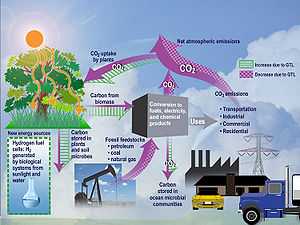Mesopredator release hypothesis
The Mesopredator release is a hypothesis that as top predators decline in an ecosystem an increase in the populations of mesopredators (see paragraph below) occurs. The hypothesis describes the phenomenon of trophic cascade in specific terrestrial communities.[1]
A mesopredator is a middle trophic level predator, which predates and is predated upon. Examples are raccoons, skunks, snakes, cownose rays, and small sharks. They are defined as medium sized.
The Hypothesis
This is a fairly new concept (2011)[1] that is gaining approval,[2] although still debated and studied. When top predator are reduced to some extent mesopredators increase and thus the predation of smaller, more vulnerable prey species such as birds.[3] [4] This may lead to dramatic prey population decline, or even extinction, especially on islands. This process arises when mammalian top predators are considered to be the most influential factor on trophic structure and biodiversity in terrestrial ecosystems.[5] Top predators may feed on herbivores and kill predators in lower trophic levels as well.[6] Thus, reduction in the abundance of top predators may cause the medium-sized predator population to increase, therefore having a negative effect on the underlying prey community.[7] The mesopredator release hypothesis offers an explanation for the abnormally high numbers of mesopredators and the decline in prey abundance and diversity.[8] The hypothesis supports the argument for conservation of top predators because they protect smaller prey species that are in danger of extinction.[3] This argument has been a subject of interest within conservation biology for years, but few studies have adequately documented the phenomenon.[9]
Criticism
One of the main criticisms of the mesopredator release hypothesis is that it argues in favor of the top-down control concept and excludes the possible impacts that bottom-up control could have on higher trophic levels.[9] This means that it supports the argument that top predators control the structure and population dynamics of an ecosystem, but it does not take into account that prey species and primary producers also have an effect on the ecosystem’s structure. Another major problem is that the hypothesis is offered as an explanation after large predators have already become rare or extinct in an ecosystem. Consequently, there is no data on the past ecosystem structure and the hypothesis cannot be tested.[10] As a result, information on the past conditions has been inferred from studies of the present conditions. However, contemporary examples of mesopredator release exist, such as the culling of cats on Macquarie Island.[11]
The hypothesis is sometimes also applied to humans as apex predators that produce top-down effects on lower trophic levels. However, it fails to recognize bottom-up effects that anthropogenic land transformations can have on landscapes on which primary producers, prey species, and mesopredators dwell.[12] Possible bottom-up effects on an ecosystem can be from bioclimatic impacts on ecosystem productivity and from anthropogenic habitat alterations.[9] Examples of anthropogenic habitat change include agriculture, grazing land, and urbanization. More importantly, the hypothesis does not take into account that higher trophic levels are affected by primary productivity. It also does not mention that trophic interactions operate at different strengths according to the ecosystem.[13] Therefore, the roles of predation and food/nutrient processes in influencing ecosystem structures remain open to controversy and further testing.[14]
See also
References
- ↑ 1.0 1.1 "Memphitis memphitis". IUCN Red List. IUCN. Retrieved 18 August 2011.
- ↑ name="date of thesis">additional sources therein)biosciencemag.org "The Rise of The Mesopredator". Biosciencemag.org. Retrieved 29 April 2012.
- ↑ 3.0 3.1 Sanicola, S. 2007. Mesopredator Release. URL: http://www38.homepage.villanova.edu/jameson.chace/Urban%20Ecology/sanicole_files/v3_document.htm. Accessed: 5-23-07
- ↑ Courchamp, F. Langlais, M. & Sugihara, G. 1999. Cats protecting birds: modelling the mesopredator release effect. Journal of Animal Ecology, 68, 282-292
- ↑ Hebblewhite, M., White, C.A., Nietvelt, C.G., McKenzie, J.A., Hurd, T.E., Fryxell, J.M. 2005. Human activity mediates a trophic cascade caused by wolves. Ecology, 86, 2135–2144
- ↑ Palomares, E. & Caro, T.M. 1999. Interspecific killing among mammalian carnivores. Am. Nat., 153, 492–508
- ↑ Crooks, K.R. & Soulé, M.E. 1999. Mesopredator release and avifaunal extinctions in a fragmented system. Nature, 400, 563–566
- ↑ Terborgh, J., Estes, J.A., Paquet, P., Ralls, K., Boyd-Heger, D., Miller, B.J. 1999. The role of top carnivores in regulating terrestrial ecosystems. In: Continental conservation: design and management principles for long-term, regional conservation networks. (eds Soulé, M. & Terborgh, J.). Island Press, Covelo, CA; Washington DC. pp. 39–64
- ↑ 9.0 9.1 9.2 Elmhagen, B., Rushton, S. 2007. Trophic control of mesopredators in terrestrial ecosystems: top-down or bottom-up? Ecology Letters, Volume 10 Issue 3 Page 197
- ↑ Sæther, B.E. 1999. Top dogs maintain diversity. Nature, 400, 510–511
- ↑ Bergstrom, D.M., Lucieer, A., Kiefer, K., Wasely, J., Belbin, L., Pedersen, T.K., Chown, S.L. 2009. Indirect effects of invasive species removal devastate world heritage island. Journal of Applied Ecology, 46, 73-81
- ↑ Larivière, S. (2004). Range expansion of raccoons in the Canadian prairies: review of hypotheses. Wildl. Soc. Bull., 32, 955–963
- ↑ Oksanen, L. & Oksanen, T. 2000. The logic and realism of the hypothesis of exploitation ecosystems. Am. Nat., 155, 703–723
- ↑ Pace, M.L., Cole, J.J., Carpenter, S.R. & Kitchell, J.F. 1999. Trophic cascades revealed in diverse ecosystems. Trends Ecol. Evol., 14, 483–488
External links
- Spatial heterogeneity of mesopredator release within an oceanic island system
- Trophic cascades in a complex terrestrial community
- Wolves drive trophic cascade in Banff National Park
| ||||||||||||||||||||||||||||||||||||||||

